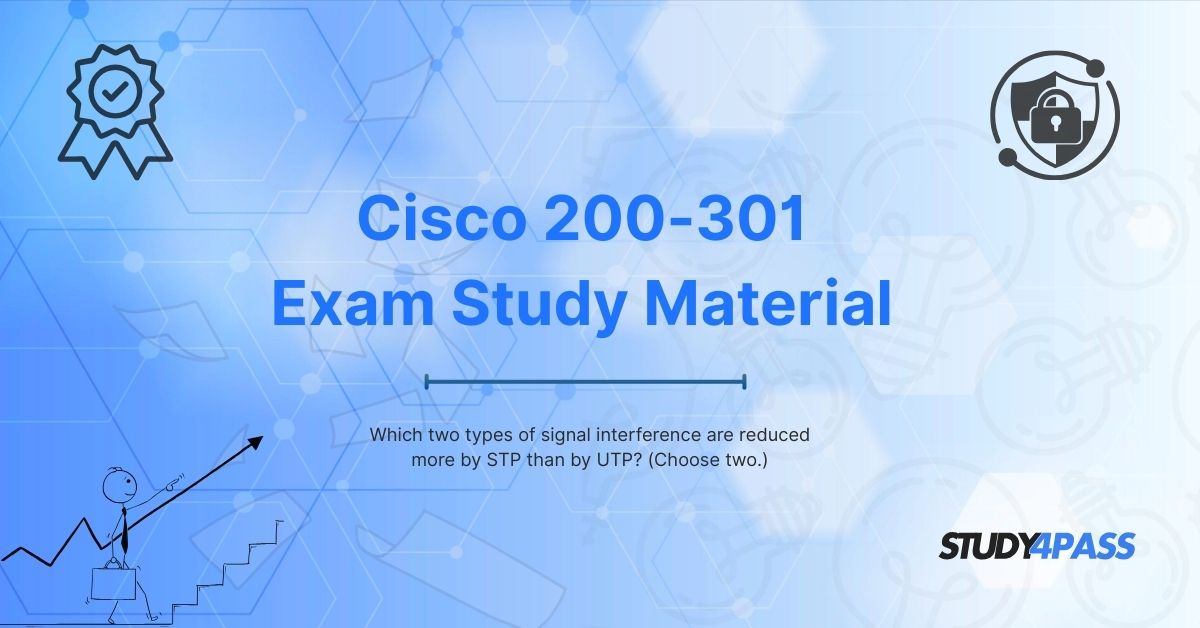Introduction
In networking, cables play a crucial role in transmitting data signals efficiently. Two common types of twisted-pair cables are Shielded Twisted Pair (STP) and Unshielded Twisted Pair (UTP). A key difference between them is their ability to mitigate signal interference. For the CCNA 200-301 exam, understanding which types of interference are better reduced by STP than UTP is essential.
This article explores:
- Types of Signal Interference in Networking
- How STP and UTP Cables Work
- Two Key Interferences Reduced More by STP than UTP
- Why STP is Preferred in High-Interference Environments
- Exam Tips for CCNA 200-301
- How Study4Pass Helps in Exam Preparation
Types of Signal Interference in Networking
Signal interference disrupts data transmission, leading to packet loss, latency, and connectivity issues. The main types include:
A. Electromagnetic Interference (EMI)
- Caused by electrical devices like motors, power lines, and fluorescent lights.
- Induces unwanted signals in cables, corrupting data.
B. Radio Frequency Interference (RFI)
- Generated by wireless devices, radio transmitters, and microwaves.
- Affects signal integrity in networking cables.
C. Crosstalk
- Occurs when signals from adjacent cables interfere with each other.
- Includes Near-End Crosstalk (NEXT) and Far-End Crosstalk (FEXT).
D. Impedance Mismatch
- Happens when signal reflections occur due to improper cable termination.
Among these, STP reduces EMI and RFI more effectively than UTP due to its shielding.
How STP and UTP Cables Work?
A. Unshielded Twisted Pair (UTP)
- Uses twisted copper wires to reduce crosstalk.
- No additional shielding, making it lightweight and cost-effective.
- Common in Ethernet networks (Cat5e, Cat6, Cat6a).
B. Shielded Twisted Pair (STP)
- Contains an extra metallic foil or braided shielding around the wires.
- Blocks external EMI and RFI effectively.
- Used in industrial environments with high interference.
|
Feature |
STP |
UTP |
|
Shielding |
Yes |
No |
|
EMI/RFI Protection |
High |
Low |
|
Cost |
Higher |
Lower |
|
Flexibility |
Less Flexible |
More Flexible |
|
Common Use Cases |
Industrial, High-Noise Areas |
Offices, Homes |
Two Key Interferences Reduced More by STP than UTP
For the CCNA 200-301 exam, the two interferences that STP reduces better than UTP are:
A. Electromagnetic Interference (EMI)
- STP’s shielding blocks EMI from external sources like power lines and electrical equipment.
- UTP lacks shielding, making it more susceptible to EMI.
B. Radio Frequency Interference (RFI)
- STP’s foil or braided shield prevents RFI from wireless devices and radio signals.
- UTP is more vulnerable to RFI in environments with strong wireless signals.
While crosstalk is reduced in both STP and UTP through twisting, STP provides additional protection against external noise.
Why STP is Preferred in High-Interference Environments?
STP is used in:
- Industrial settings (factories with heavy machinery).
- Medical facilities (near MRI machines and medical equipment).
- Data centers with high-density cabling.
- Outdoor installations near power lines.
However, STP is more expensive and less flexible than UTP, making UTP the standard for most office networks.
Exam Tips for CCNA 200-301
- Remember: STP reduces EMI and RFI better than UTP.
- Understand scenarios where STP is necessary (e.g., factories, hospitals).
- Know cable categories (Cat5e, Cat6, Cat6a) and their shielding types.
- Practice questions on interference types and cable selection.
How Study4Pass Helps in CCNA 200-301 Exam Preparation?
Preparing for the CCNA 200-301 exam requires reliable study materials and practice tests. Study4Pass offers:
- Up-to-date CCNA study guides
- Real exam-like practice questions
- Detailed explanations for networking concepts
- Interactive labs and simulations
- Expert tips for passing the exam on the first attempt
By using Study4Pass, you can master topics like STP vs. UTP, interference types, and network cabling efficiently.
Conclusion
For the CCNA 200-301 exam, knowing that STP reduces EMI and RFI more effectively than UTP is crucial. While UTP is common in most networks, STP is essential in high-interference environments.
For the best exam preparation, trust Study4Pass for comprehensive CCNA training materials and practice tests.
Special Discount: Offer Valid For Limited Time “200-301 Study Material”
Actual Exam Questions For Cisco's 200-301 Certification
Sample Questions For Cisco 200-301 Practice Exam
1. Which two types of signal interference are reduced more by Shielded Twisted Pair (STP) than by Unshielded Twisted Pair (UTP)? (Choose two.)
A) Radio Frequency Interference (RFI)
B) Signal Attenuation
C) Electromagnetic Interference (EMI)
D) Crosstalk
E) Latency
2. Compared to UTP, STP provides better protection against which of the following interferences? (Choose two.)
A) Electromagnetic Interference (EMI)
B) Packet Loss
C) Radio Frequency Interference (RFI)
D) Bandwidth Limitation
E) Signal Reflection
3. What are the two primaxry types of interference that STP cables mitigate more effectively than UTP cables? (Choose two.)
A) Impedance Mismatch
B) Electromagnetic Interference (EMI)
C) Signal Dispersion
D) Radio Frequency Interference (RFI)
E) Jitter
4. STP cables are more effective than UTP cables in reducing which of the following? (Choose two.)
A) Network Congestion
B) Electromagnetic Interference (EMI)
C) Data Collision
D) Radio Frequency Interference (RFI)
E) Propagation Delay
5. Which two interference types are better suppressed by STP due to its shielding? (Choose two.)
A) Electromagnetic Interference (EMI)
B) Signal Refraction
C) Radio Frequency Interference (RFI)
D) Data Corruption
E) Ping Latency


